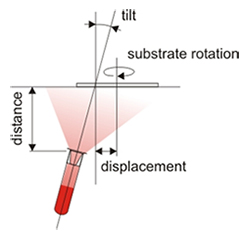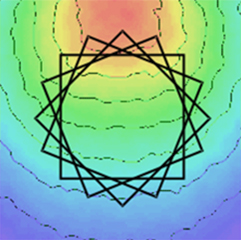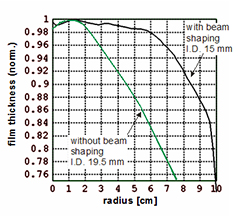Monte Carlo simulation of thin film deposition in R&D type physical vapor deposition and MBE systems
Cross-section of an MBE system. Multiple radially arranged effusion sources are used to deposit materials onto a rotating substrate.

-
Why MC-Simulation?
It provides important information while saving time and money
-
MC-Simulation allows the optimization of
- source design
- source arrangement
- deposition chamber layout
-
It provides information about
- layer uniformity
- material efficiency
- layer composition -
For single material deposition and co-evaporation
-
For planar, patterned or textured substrates
Monte Carlo simulation allows to calculate the angular flux distribution of various types of effusion cells with or without beam shaping inserts. It provides information on the resulting flow rate distribution, material composition on the substrate, and material efficiency, which allows to optimize the system design.
An example of a multible MBE system is shown in the figure above. Multiple radially arranged effusion sources are used to deposit materials onto a rotating substrate. The substrate is often a three to six inch diameter semiconductor wafer in face-down position.
 Geometry of substrate and evaporation source |
 Calculated 2D flux distribution |
An example is shown in the left figure above. It shows an effusion cell that allows evaporating material onto a rotating 100x100 mm² substrate wafer or glass plate. The right figure shows the calculated 2D flux density distribution (25-100%) for an effusion cell with beam shaping element inserted in the orifice of the effusion cell. The simulated window size is 200x200 mm². The substrate is the rotating 100x100 mm² plate.
 Normalized thickness profile for the deposited layer with (black) and without beam shaping insert in the effusion cell (green). |
The normalized thickness profile derived from the 2D flux density map is shown below. In one case the effusion cell is equipped with a beam shaping insert (black curve). In the second case, where the effusion cell is without insert, the flux distribution is defined by the cylindrical crucible, which results in a strong drop of the thickness profile with increasing radius. |
We offer the deposition simulation for your MBE or PVD system as a service. For a specific simulation geometrical boundary conditions of the deposition setup are required.
